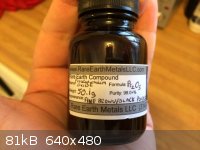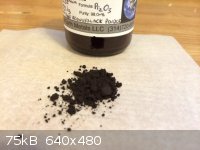gdflp
Super Moderator
      
Posts: 1320
Registered: 14-2-2014
Location: NY, USA
Member Is Offline
Mood: Staring at code
|
|
Praseodymium Oxide
I recently received about 50g of praseodymium oxide. However, instead of being pure Pr2O3 it is mixed valence
Pr6O11. Is there any way to reduce all of the praseodymium into it's normal +3 valence state?
|
|
|
woelen
Super Administrator
        
Posts: 7977
Registered: 20-8-2005
Location: Netherlands
Member Is Offline
Mood: interested
|
|
Why is this important to you? I also have Pr6O11 and this dissolves in acids quite easily (with production of oxygen or production of Cl2 if the acid
is HCl), giving a pale green solution, which contains Pr(3+) ions. If you use it in ceramic processes, then Pr6O11 works equally well. All
commercially available praseodymium oxide is Pr6O11, I have never seen pure Pr2O3. If you heat Pr2O3 in contact with air, then it absorbs oxygen.
|
|
|
gdflp
Super Moderator
      
Posts: 1320
Registered: 14-2-2014
Location: NY, USA
Member Is Offline
Mood: Staring at code
|
|
Won't using Pr6O11 result in mixed valence compounds when dissolved in acids?
|
|
|
blogfast25
International Hazard
    
Posts: 10562
Registered: 3-2-2008
Location: Neverland
Member Is Offline
Mood: No Mood
|
|
No, as woelen explained: the higher oxidation state gets reduced to III, hence the Cl2 or O2 evolution.
[Edited on 21-2-2014 by blogfast25]
|
|
|
Mailinmypocket
International Hazard
    
Posts: 1351
Registered: 12-5-2011
Member Is Offline
Mood: No Mood
|
|
I purchased some of this compound as well from a seller online. Should I assume this is Pr6O11 also or could it actually be the
trioxide?
 
|
|
|
blogfast25
International Hazard
    
Posts: 10562
Registered: 3-2-2008
Location: Neverland
Member Is Offline
Mood: No Mood
|
|
Quote: Originally posted by Mailinmypocket  | I purchased some of this compound as well from a seller online. Should I assume this is Pr6O11 also or could it actually be the
trioxide?
|
Assume the mixed oxide. It's likely to have been calcined, so it won't be pure Pr(III) oxide. Assuming you actually want to use it then dissolving in
acid should tell you for sure. But some of these oxides don't respond well to even the most concentrated of strong acids.
Try a small amount with strong HCl and observe for chlorine.
[Edited on 22-2-2014 by blogfast25]
|
|
|
aleskva
Harmless

Posts: 6
Registered: 5-5-2015
Member Is Offline
Mood: No Mood
|
|
I have got a similar problem. I have got black powder of Pr6O11 and I want to change it to Pr2O3 and then
dissolve it in H2SO4 and crystallize green Pr2SO4.8H2O crystals. I haven't got HCl, but I have
got N2H4 or H2O2. Could I change Pr6O11 to Pr2O3 using one of
these two compounds (which both should work well in my opinion)?
|
|
|
gdflp
Super Moderator
      
Posts: 1320
Registered: 14-2-2014
Location: NY, USA
Member Is Offline
Mood: Staring at code
|
|
As explained above to me(a year ago, I am now amazed at my lack of knowledge then), when the Pr6O11 is dissolved in any acid,
sulfuric acid included, then the praseodymium will be reduced to the Pr<sup>3+</sup> oxidation state. No need to waste hydrazine on this.
The relevant chemical equation is Pr6O11 + 9H2SO4 --> 3Pr2(SO4)3 +
9H2O + O2 I don't believe that Pr<sup>4+</sup> is stable under standard conditions in aqueous solution, hence if
any was formed, it would immediately get hydrolyzed(reduced).
Edit:Added note from post by blogfast
[Edited on 5-5-2015 by gdflp]
|
|
|
aga
Forum Drunkard
    
Posts: 7030
Registered: 25-3-2014
Member Is Offline
|
|
That's cheery and gives great hope !
I'm still amazed at my lack of knowledge, then and now.
|
|
|
blogfast25
International Hazard
    
Posts: 10562
Registered: 3-2-2008
Location: Neverland
Member Is Offline
Mood: No Mood
|
|
Quote: Originally posted by gdflp  | | I don't believe that Pr<sup>4+</sup> is stable under standard conditions in aqueous solution, hence if any was formed, it would
immediately get hydrolyzed. |
'Reduced' (by water) is a better way of putting it. Hydrolysis is more associated with acid/base chemistry.
Did your oxide dissolve easily? If so, in what acid?
[Edited on 5-5-2015 by blogfast25]
|
|
|
gdflp
Super Moderator
      
Posts: 1320
Registered: 14-2-2014
Location: NY, USA
Member Is Offline
Mood: Staring at code
|
|
Sorry blogfast, I didn't see your question until just now. I didn't have any notes on my previous experiments, so I just tried it again on a test
tube scale. It's insoluble in conc. H2SO4, that's not surprising though, I was expecting that. It did dissolve in dilute acids
though rather readily. ~20% HNO3 had the fastest reaction, it began hissing and violently bubbling as soon as some
Pr6O11 was added. ~30% H2SO4 dissolved it quite rapidly as well. I got surprising results with ~15% HCl
however. It dissolved remarkably slowly(took about 5 minutes to accomplish what took the other two around 15 seconds) and no chlorine scent was
noted. Any ideas?
|
|
|
aleskva
Harmless

Posts: 6
Registered: 5-5-2015
Member Is Offline
Mood: No Mood
|
|
Thank you for your help. I want to change all Pr(4+) to Pr(3+) from that dark oxide Pr6O11 because I need to prepare as many
crystals as possible for following analyse (and the oxide is not so cheap as well). And I want the crystals to be Pr(3+) (in
Pr2(SO4)3.8H2O).
|
|
|
aleskva
Harmless

Posts: 6
Registered: 5-5-2015
Member Is Offline
Mood: No Mood
|
|
Finally, I tried to dissolve black powder of Pr6O11 in calculated amount of 20% H2SO4. Not more than
needed, because it couldn't crystallize product I wanted to make. The acid solution was transparent blackish with black powder stirred, not soluted. I
tried to add distilled water, but nothing changed. The black color is typical for Pr(4+) or mixed Pr(3+,4+). I needed Pr(3+) so I tried to add 30%
peroxide. At first just drops, finally tens of ml. And it was the right step. The black stirred powder was completely soluted and the transparent
solution was finally bright greenish (between green-yellow), which indicates me only Pr(3+) are present. I am letting it crystalize freely. Hope it
helps anybody in a future ;-)
|
|
|
gdflp
Super Moderator
      
Posts: 1320
Registered: 14-2-2014
Location: NY, USA
Member Is Offline
Mood: Staring at code
|
|
Interesting, those results differ from mine. Did you observe any release of gasses when you added the Pr6O11? My dilute acid
was warm because I prepared it freshly by diluting conc. acid, so perhaps some heat is beneficial here. Glad you got it to work, but I bet that if
you let it sit for a few mins, it would have dissolved if you had observed effervescence.
I just had another thought. Because the mixed oxide contains praseodymium(IV), could this higher oxidation state provide enough energy for a
magnesium thermite to be favorable?
|
|
|
blogfast25
International Hazard
    
Posts: 10562
Registered: 3-2-2008
Location: Neverland
Member Is Offline
Mood: No Mood
|
|
Quote: Originally posted by aleskva  | Finally, I tried to dissolve black powder of Pr6O11 in calculated amount of 20% H2SO4. Not more than
needed, because it couldn't crystallize product I wanted to make. The acid solution was transparent blackish with black powder stirred, not soluted. I
tried to add distilled water, but nothing changed. The black color is typical for Pr(4+) or mixed Pr(3+,4+). I needed Pr(3+) so I tried to add 30%
peroxide. At first just drops, finally tens of ml. And it was the right step. The black stirred powder was completely soluted and the transparent
solution was finally bright greenish (between green-yellow), which indicates me only Pr(3+) are present. I am letting it crystalize freely. Hope it
helps anybody in a future ;-)
|
That trick also works for Ce(+4) to Ce(+3).
Well done!
|
|
|
aleskva
Harmless

Posts: 6
Registered: 5-5-2015
Member Is Offline
Mood: No Mood
|
|
Quote: Originally posted by gdflp  | | Interesting, those results differ from mine. Did you observe any release of gasses when you added the Pr6O11? My dilute acid
was warm because I prepared it freshly by diluting conc. acid, so perhaps some heat is beneficial here. Glad you got it to work, but I bet that if
you let it sit for a few mins, it would have dissolved if you had observed effervescence. |
Yes, I forgot, when I tried to dissolve Pr6O11 in sulfuric acid, it warmed up itself for a while and a poignant gas was being
released. I am not really sure, what gas it was, but its releasing didn't help oxide to solute anyway. To dissolve it faster, I think you should cool
the solution.
P.S.: I was stirring it during the whole process...
[Edited on 6. 5. 15 by aleskva]
|
|
|
aleskva
Harmless

Posts: 6
Registered: 5-5-2015
Member Is Offline
Mood: No Mood
|
|
Yes, you are right, but my colleague also tried it today (he tried to prepare cerium(III) sulfate from cerium(IV) oxide) and unfortunately he was
unsuccessfull somehow. He couldn't dissolve that oxide, no matter how many distilled water or 30% peroxide he added.
[Edited on 6. 5. 15 by aleskva]
|
|
|
aleskva
Harmless

Posts: 6
Registered: 5-5-2015
Member Is Offline
Mood: No Mood
|
|
Quote: Originally posted by gdflp  | | I just had another thought. Because the mixed oxide contains praseodymium(IV), could this higher oxidation state provide enough energy for a
magnesium thermite to be favorable? |
I don't know if I understand you correctly, but Pr(IV) oxide when heated in air (O2) over 200 °C falls part
|
|
|
gdflp
Super Moderator
      
Posts: 1320
Registered: 14-2-2014
Location: NY, USA
Member Is Offline
Mood: Staring at code
|
|
I just noticed something interesting. I went to clean up the test tubes from my dissolution tests several posts when I noticed something. The test
tube which contained the conc. sulfuric acid and the praseodymium oxide has, over the course of the past several months, apparently reacted. The
black oxide powder has disappeared and is replaced with light green crystals of praseodymium sulfate. I'm unsure if the reaction is just extremely
slow between the conc. acid and the oxide, but I have a theory as to what happened. I'm guessing that over the course of the past few months, which
have been very humid, the sulfuric acid, which was exposed to the open air, absorbed water from the atmosphere, reducing the concentration of the acid
enough to allow it to react.
|
|
|